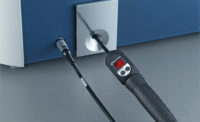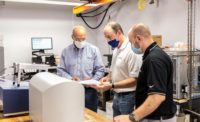When it comes to the production of automobiles, trucks, heavy-duty equipment, off-road vehicles and farm equipment, early detection and resolution of even the smallest leaks are key to minimizing recall-related expenses.
Leak detection is important throughout the manufacturing process, and especially critical on the final assembly line. On the final line, delivering swift, easy, operator-friendly leak detection is a must for quality and ensuring customer satisfaction.
What is a leak?
Defining a leak is relatively easy. It is a hole, crack or porosity in a forging, casting, tubing, blow-molded container or polymeric hose. During final assembly processes, leaks are typically caused by missing or misaligned seals, missing O-rings, foreign matter or incomplete tightening.
Leaks may be molecular in size when they occur in castings, particularly aluminum. Finding and fixing leaks at their source is not only crucial to initial vehicle quality that is measured, reported and scored for consumers by a variety of organizations, but also to overall product lifecycle quality and longevity.
Where are they found?
While leak detection takes place throughout the production process, a final check should take place on the final assembly line, when all components have been fitted in a vehicle’s fuel and air-conditioning systems.
Fuel and air-conditioning systems are extensively regulated regardless of whether the application is in passenger cars, over-the-road trucks, heavy-duty equipment or farm vehicles. For both safety and regulatory reasons it is especially important to identify leaks in fuel or air-conditioning systems before a vehicle rolls off of the final assembly line.
How have leaks been tested previously?
Historically, several test methods have been used to detect leaks. The two most common have been bubble testing and pressure-decay testing, both of which are no longer suitable for final-line quality checks.
For many types of components, bubble testing has been used, but it is simply not suited for use during final assembly operations.
Bubbles can be detected by immersing a pressurized part in water—nearly impossible during final assembly—or spraying it with a water-and-soap solution. At a leak rate of 0.6 sccm (1.0 x 10-2 atm-cc/sec), a bubble takes 1.5 seconds to form. Finer leaks of 1.0 x 10-5 atm-cc/sec (which is close to the 2 gram/year refrigerant leakage specification) can take 25 minutes before a single bubble is formed. Using a water-soap solution to coat parts, or even an entire engine, then waiting for bubbles to form might take hours and also requires line-of-sight visual verification.
In addition, spilled water-soap solutions can create slippery, unsafe work areas. Water and water-soap solutions also can damage electrical sensors and components.
Pressure-drop or decay testing requires pressurizing a part and waiting for observable differences in pressure. Both methods are time consuming. A pressure-drop test also can be adversely affected by “creepage” in plastic parts. The main drawback of each of these testing methods is their dependence on consistent temperature and humidity.
Baseline testing during final assembly.
Testing using gases such as helium or forming gas (typically five percent hydrogen, 95 percent nitrogen) is well-known and accepted for testing single parts under pressure or in a vacuum.
None of these methods—pressure-decay, bubble testing or single part gas tests—are suitable for use at the end of a production line where testing for leaking hydrocarbons from a fuel system or fluorocarbons from air conditioning system is a necessity.
According to industry sources, less than a third of all automotive OEMs continue to use bubble or pressure-decay testing during final assembly. Outside of the automotive industry, however, up to 80 percent of all manufacturers rely on these types of tests, particularly when inspecting air-conditioning systems.
The refrigeration and air conditioning industries have been using this type of leak testing in production settings for more than a decade. Because of drivers from the EPA and the migration to potentially flammable refrigerants, the automotive industry is now embracing production grade leak detection equipment in final assembly.
What is state of the art for refrigerant testing?
Despite climate change concerns, no current industry standard for refrigerant leak testing exists for final assembly in any segment of the industry.
Unfortunately, while there are SAE J-specification guidelines, there is nothing required as in the case of emissions or air-bag testing. This creates choices that affect quality costs and provide incentives to improve processes for off-road equipment and farm vehicles. Brand loyalty and field service costs aside, there is an inducement for industry-wide process improvement, although regulations eventually will force change.
In 1995 the most well-known automotive refrigerant changed from R12 (Freon) to R134a. R134a recently was replaced by R1234yf, a more earth-friendly refrigerant. Some European manufacturers, however, are switching to R744, which is pure CO2.
Leak requirements for R134a are 1.0x1.0-5 mbar-l/s or less than three grams per year, which is nearly undetectable with water tests still in use by some manufacturers. System pressure for R1234yf and R134a are approximately 300 PSI. Some manufacturers, however, consider R1234yf flammable. It also costs approximately 10 times more. With R1234yf, cost and flammability make testing even more critical.
While R744 (CO2) is non-flammable, it requires a system pressure of 2,000 PSI. R134a has a Global Warming Potential (GWP) of 1,300; R1234yf drops the GWP to 4, and R744 is neutral at a GWP of 1.
Helium, pressure-decay and sniffer leak detection.
Tier suppliers currently use helium-gas testing to ensure that OE manufacturers of all types receive leak-free components (hoses, evaporator, condenser, dryer, compressor, etc.) at a desired maximum leak rate of 2-5 grams per year. During final assembly, however, some manufacturers continue to use pressure-decay tests, which can only discover gross leaks of 1,000-10,000 grams per year. Others use sniffer leak detectors at various testing rates up to 100 percent, not statistical or batch testing.
When testing on an assembly line, various problems can be identified, including failures in post-run brazed joints due to vibration, pressure and temperature. Other leaks are commonly caused by missing, crushed, cut or even dirty O-rings. Each joint or connection point may be tested by an operator or robotically.
What is state of the art for fuel leak testing?
The switch to electronic fuel injection (EFI) in automotive applications began in the mid-1970s, but more recently, the desire for greater fuel efficiency and tighter emissions standards have resulted in Gasoline Direct Injection (GDI) fuel systems that have increasingly replaced EFI.
During production at Tier suppliers, GDI components are typically helium leak-detected in subassemblies. While GDI delivers better fuel economy and greater control over emissions, fuel delivery pressures have increased from 100-200 PSI up to 2,000 PSI or more.
Production-line testing of fully assembled fuel systems requires sniffer-type leak detection.
Assembly-line solutions for multiple test requirements.
Ideally, manufacturers could simultaneously test for leaking fuel and refrigerant whether they are diesel, gasoline, gaseous fuels, R134a or R1234yf. As R134a is replaced by R1234yf there will be “legacy” systems on vehicles that use an older refrigerant and newer models on the same line employing R1234yf. A leak detector that can detect both refrigerants, while also clearly distinguishing between them, is a necessity for this type of mixed production line.
Simultaneously testing for fuel leaks in a process that takes 20 seconds or less is possible. Three production lines in North America currently do this type of testing.
High-pressure fuel systems present a particular challenge for automakers. No one wants fuel under high pressure spraying onto a hot engine.
Refrigerants that replace R-134a such as R-1234yf are considered flammable and also must operate in a leak-proof environment. Assembly-plant quality-control managers today are looking for state-of-the-art “sniffer” equipment to detect refrigerant leaks in mobile air-conditioning systems and fuel leaks in direct-injection systems on final assembly lines.
R134a, for example, has a pressure of about 300 psi, but its global warming potential, about 1,300 grams per year, is of importance. R134a is likely to be discontinued by 2020.










